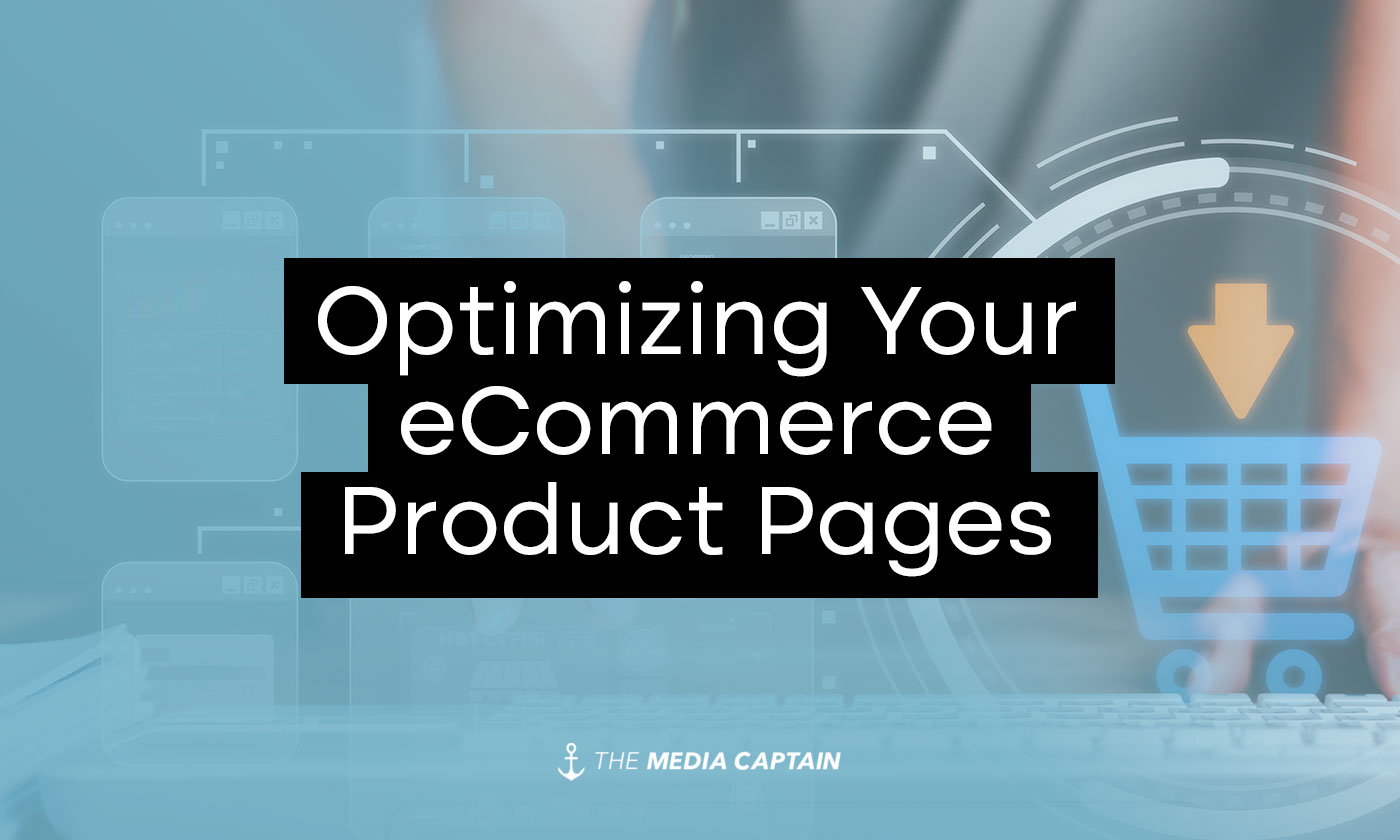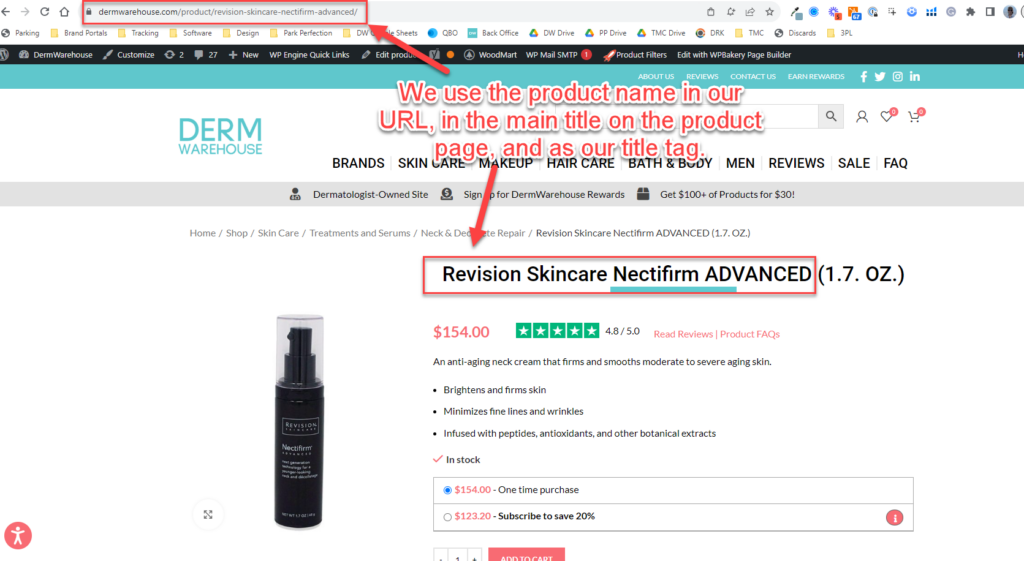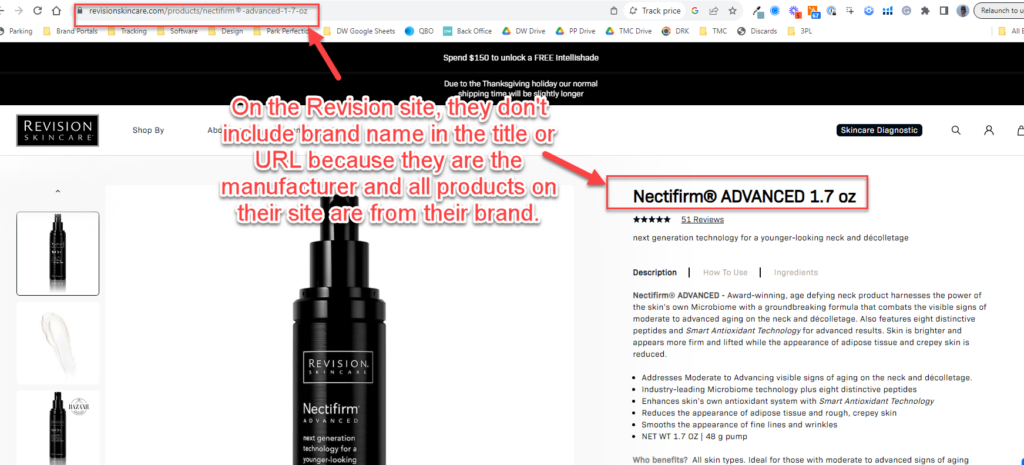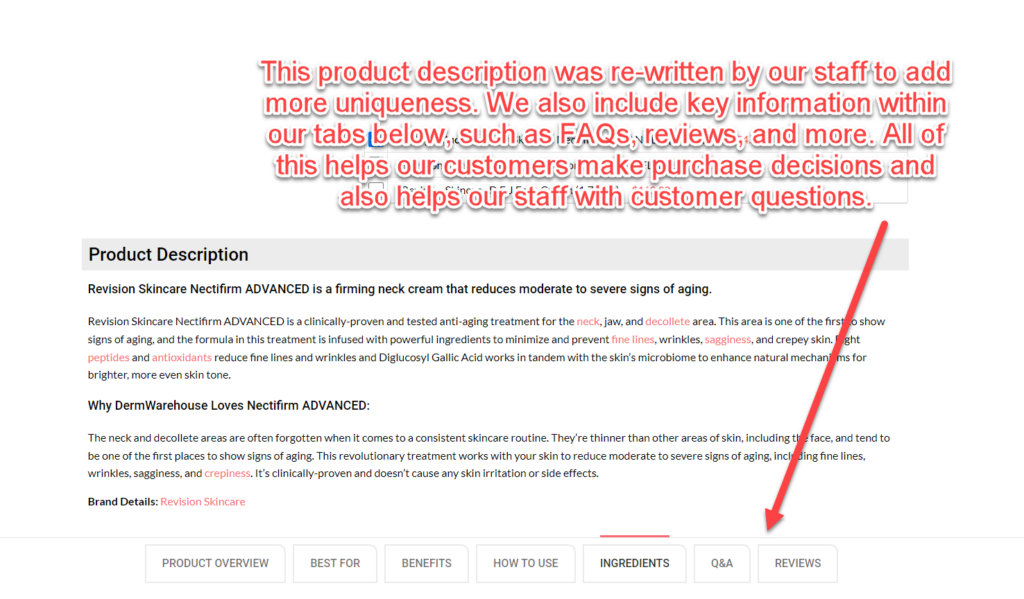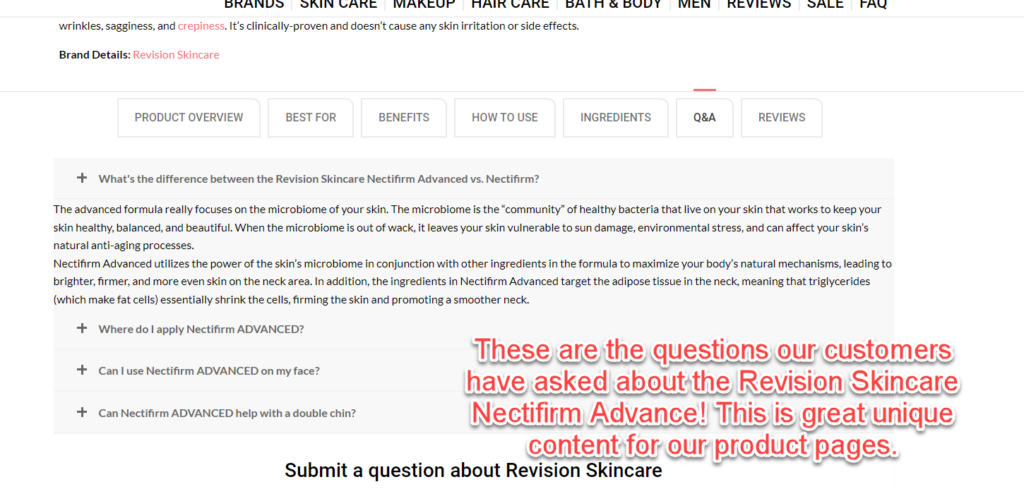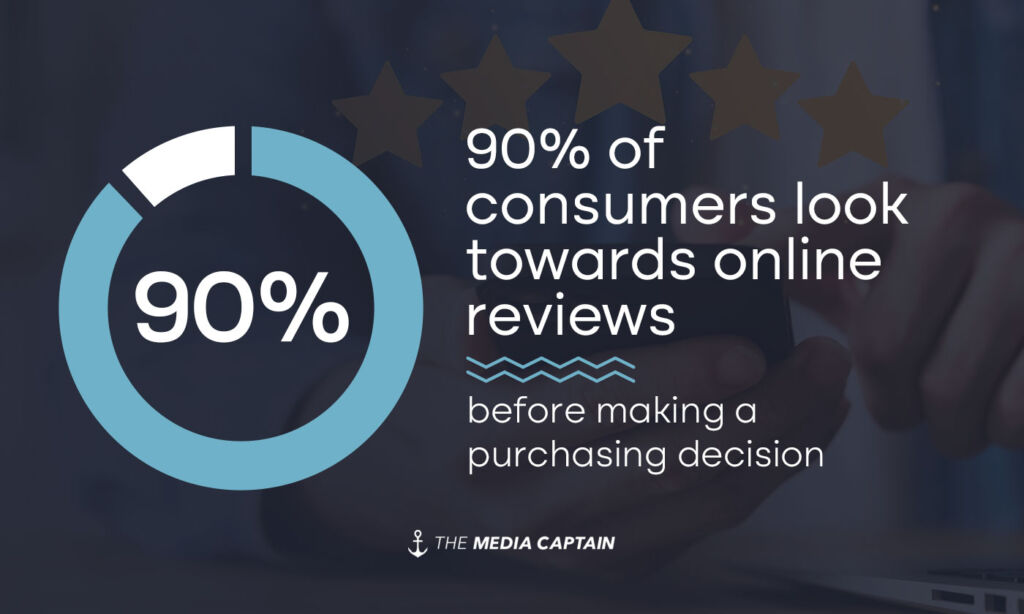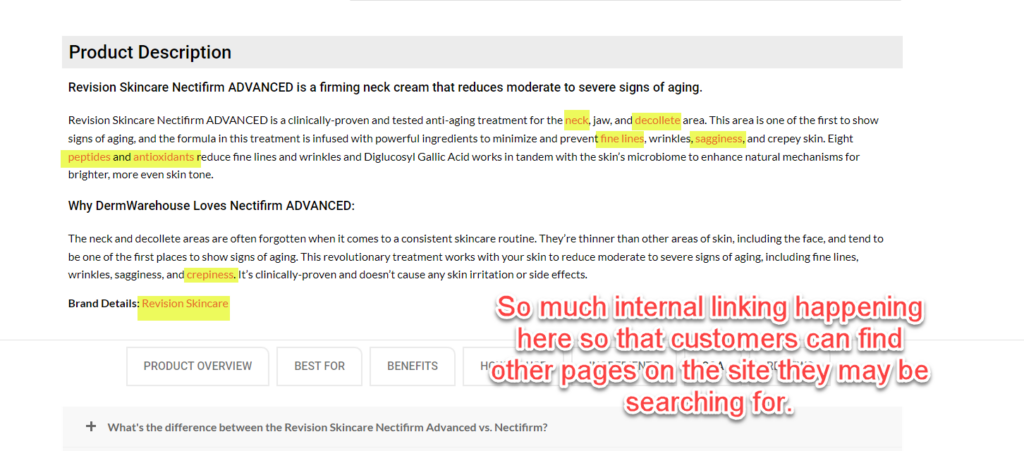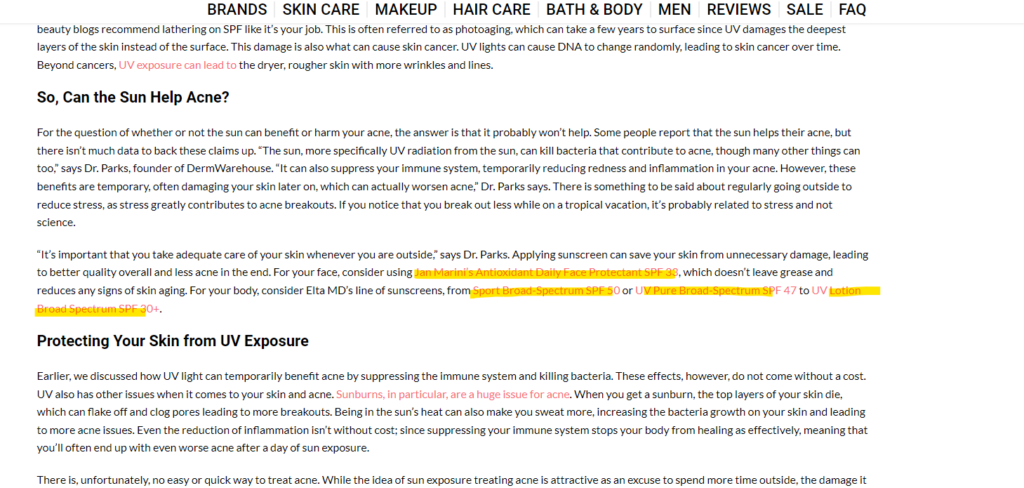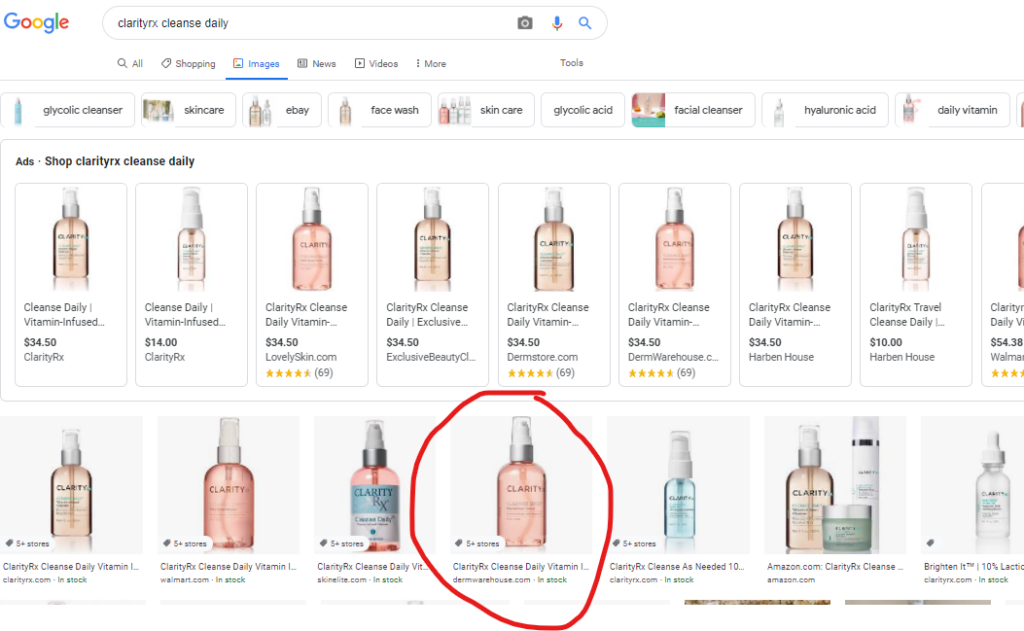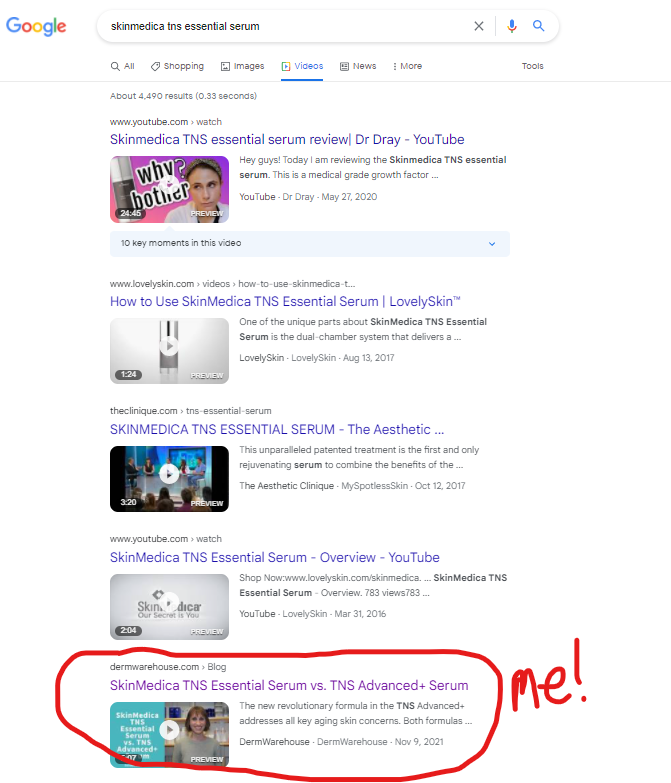If you’re an eCommerce business owner, you know just how much work it takes to set up product pages for your site. Between gathering all of the product information and creating perfectly crafted descriptions, product specs, highlights and more, there’s a lot that goes into this. Not only do you want your product pages to look amazing and read beautifully, you also want to optimize your eCommerce product pages for SEO. Doing so will increase your exposure on Google and other search engines, making them (and you!) easier for your customers to find.
Table of Contents
SEO is extremely important because it’s earned placement on search engines that’s completely free. There are two ways of getting your product pages to show up at the top of search results: 1) run ads, which you’ll pay for per click, or 2) earn the placement with organic listings, where clicks are free! If you can get something for free vs. paying for it, this is obviously ideal, but these earned placements take time and a lot of work. Building a killer SEO strategy (and some patience) is how you can earn these spots. A big part of this is optimizing the content on your site to be search-engine friendly, which is what this article is all about.
[Check out this podcast that I recorded to learn more about the basics of SEO!]
When we first launched our in-house eCommerce brand, DermWarehouse.com, we spent a year building our site and preparing to launch. A good portion of that time was spent writing the content for every single product we’d be selling, which at the time was about 500 (now we’re up to over 2,000). I’d scrutinize every word and try to come up with the most creative and eloquent ways to describe the skin care products we were selling. At the time, while I was familiar with SEO and its importance, I hadn’t learned all the tricks for optimizing product pages for eCommerce. Now years later, my team and I are constantly going back to old product pages to enhance these, not only so they contain all of the information our customers need, but so that they are written with search engines in mind as well. The good news is that your optimization can be an ongoing process. We’ve made so many changes on our site along that way that have really moved the needle in terms of our search visibility.
Over the years, I’ve done a lot of research and experimentation with SEO. While the rules are always changing and evolving, there are certainly some tried and true methods that should be followed:
Optimize Your URL, Title, & Title Tag to Reflect the Name of Your Product
The URL is one of the most important ranking factors when it comes to eCommerce SEO. For DermWarehouse, you’ll see how we structure our eCommerce product page URL’s to include the name of the product in the URL string. If you are selling a product from a manufacturer, this is an absolute necessity, as this is what someone will be searching for on Google.
- https://dermwarehouse.com/product/revision-skincare-nectifirm-advanced/
Along with including the name of the product in the URL structure, we also it as the main title & title tag on the site.
If we look at the Revision Skincare site, the manufacturer of the product I referenced above from DermWarehouse, you can see that their URL structure & product name are slightly different. They don’t include their own brand name within the product title or URL because all of the products their selling on their site are coming from them. Customers come to their site and know that they are looking at all Revision Skincare products. When people come to the DermWarehouse site, they could be looking at one of a hundred different brands, so we need to make sure our title and URL list the brand clearly.
Learn More: Creating the Best URL Structure for SEO
Create Useful & User Friendly Content
Creating content for eCommerce product pages can be an extremely daunting task. When I was launching DermWarehouse and creating hundreds of product pages, I utilized any help I could get. Since we’re a reseller of many skincare brands, I took advantage of the fact that these brands had already created great content for their products and I copied a lot of what they had already written. Of course, they gave me permission to do so (and often recommended it), plus the content was extremely detailed and very well-written, but by copying it onto my website, I was creating duplicate content, which is frowned upon by Google.
What is important to Google, is creating content that is user friendly and has your customers in mind. You want to make sure that your product pages give your customers all of the information they’ll need to make informed decisions when shopping. For us, that means including detailed product descriptions, ingredient lists, product photos, reviews, and instructions on how to use the products.
When we were getting started it would have been impossible for me to launch a site while also writing completely unique content on every product page. I made the decision to use what our brands supplied for us, which I knew would give the best experience to our customers and also be the most helpful for our staff. Over the years, we’ve continuously gone back to our product pages to enhance and re-write content to add our own information, FAQ’s and more.
Add FAQs to Product Pages
As you’re thinking about the best content to add to your product pages, we’ve found that adding FAQs are an easy and very effective way to create unique content that’s also extremely helpful for both your customers and your customer service team. As different questions come up from customers, keep a list of these and add them onto your product pages. Chances are if one person had a question about your product, others will too. Then, when these questions are asked, your customer service team can use the verbiage directly from the product page to answer customer questions!
Use H1’s & H2’s Properly
According to Search Engine Journal, “Google is rewriting title tags for a limited amount of pages in search results, often replacing the text with a page’s H1 tag. It’s known that Google adjusts titles in SERPs by making small tweaks, such as appending a business’s name to the end. But now Google is overriding titles with different text.”
What this means is that your title tags on each page are sometimes being replaced by the H1s and H2s on the same pages (your top level and second level headings). Therefore, It’s important that you utilize strong H1s and H2s, as these can essentially be pulled into Google as the main title of your page. Make sure you’re breaking your product descriptions into different sections and using appropriate headers for each of the sections.
Get Product Reviews
Product reviews help customers make informed decisions and help legitimize your brand and products. When we launched our skin care line, Park Perfection, as much as we touted the product and talked about its benefits, getting customer reviews greatly helped us increase our conversion rate. These reviews gave our customers more confidence in our product because they knew how much other people liked it.
If you want your product reviews to pull into Google (organic and paid), you’ll need to use a review platform that’s a Google partner. If you look at the example below you can see the review rating from the Park Perfection Instant Eye Lift product page populating in Google’s search results. This is populating from the DermWarehouse site, since we use a Google partner for that business (TrustPilot).

The review rating snippet is derived from Schema Markup placed on your site (learn more about Schema).
When you sign up for a service like Yotpo or TrustPilot, you can get review ratings to populate in organic search, PPC Ads and Google Shopping Ads. The price point isn’t cheap for these review software’s (we pay over $900 per month for TrustPilot). It could be well worth it for your business for the following reasons:
- The importance of online reviews when making a purchase (90% as mentioned above)
- We’ve seen an uptick with our eCommerce clients of between 7%-15% (depending on the industry) when they have 10+ reviews on a product page
- Reviews populating in PPC Ads and Google Shopping Ads help increase conversion rate to your product page
- Reviews will make your organic listings better stand out versus competitors who don’t have reviews
Learn More: How to Get More Reviews for Your eCommerce Business
Internal Linking
An internal link is a hyperlink on your website that goes from one page or post to another page or post on your site. Internal links help Google find, index and understand the pages on your site. Not only that, internal links provide a good experience for your users because they allow customers to easily get from one page to another, as they’re browsing your site looking for information.
Learn More: What is Internal Linking and How Can it Help My SEO
We do a ton of internal linking on the DermWarehouse site. This greatly helps our customers navigate throughout our site, which helps with user experience, and in turn, SEO (Google loves sites with a good user experience). As you can see in the product description below, as we’re describing the product we include internal links to other category pages on the site. Maybe when a customer reads this description for the Revision Skincare neck product, they want to look at other neck products that we offer. The internal linking below makes it easy for them to do that.
We also do a lot of internal linking from our blog to product pages on our site. If someone is reading our blog about “Does the Sun Help Acne?” they will likely be interested in some of our products for sun protection and/or some of our products for acne. We always ensure that we recommend products that are related to the blog topic for easy shopping.
Backlinks to Your Product Pages
We can’t have a blog about SEO without mentioning backlinks – these are the foundation of SEO! Backlinks are hyperlinks from an external site pointing back to your site. When an authoritative site is pointing back to your site, it helps build legitimacy for your site. These quality backlinks are extremely important for Google and will help with your SEO.
For DermWarehouse, we ‘ve worked hard over the years to acquire as many high quality backlinks as possible pointing back to our website. We have a skin care expert as part of our team (dermatologist, Dr. Alan Parks). We’ve built relationships with reporters who write about skin care and they use Dr. Parks as a source in their articles. For example, a reporter may be writing an article about the benefits of Retinol in skin care. We would provide a quote from Dr. Parks about retinol and also add in product recommendations. We always ask that the reporter link back to the product page on the DermWarehouse site when they use our quote. Dr. Parks has contributed to articles in Women’s Health, Today.com, Glamour, Us Weekly, Cosmopolitan, and more.
Learn More: How to Acquire High Quality Backlinks
Utilize an SEO Plugin
One of the best ways to ensure you’re doing everything right on your product pages is to utilize an SEO plugin. For DermWarehouse, we use Yoast SEO, which will allow you to enter your SEO title and description and also give you an SEO analysis based on the content of your product pages.
As you can see in the examples below, the Yoast plugin tells us if our SEO title and description are the correct character lengths. It also grades us on many other factors. Even on this page, you can see that we can make an improvement by adding more text so that we have at least 300 words. Yoast also recommends that we add an external link, however, this is not something we ever add to product pages since we don’t want to direct customers away from our website.
While SEO plugins are great, you do have to take some of their recommendations with a grain of salt and remember that most important is to ensure the user experience on your product pages is top notch.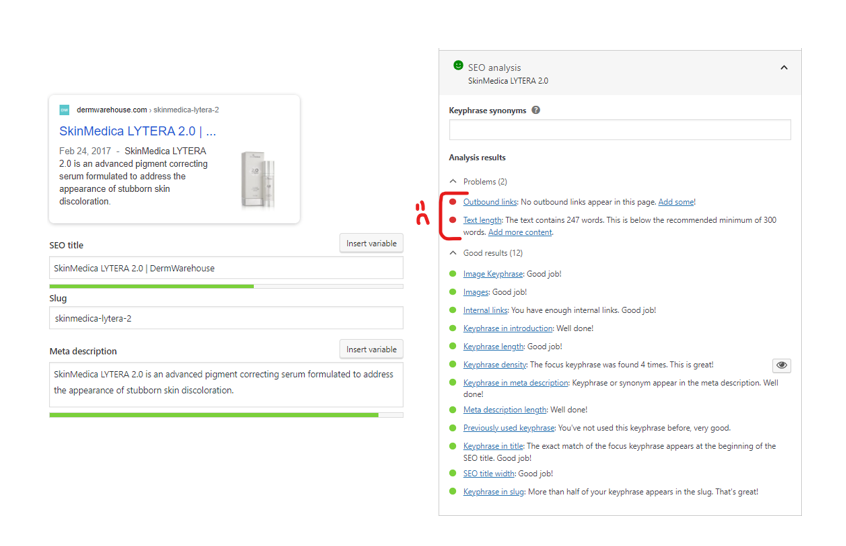
Name Images Properly
One very important product page element for SEO are the images, yet many people overlook these. It’s easy to grab an image with a random file name like screen-shot-1.jpg and upload that to your site. This is a big no-no! Over 20% of all U.S. web searches happen on Google Images [SOURCE], so you want to make sure your images are named properly so that you’re taking advantage of all of these web searches! Search Engine Journal had a great analogy when they said, “Not customizing your image file name is like getting a burrito with nothing in it!”
Google uses the URL path as well as the file name to help it understand your images. Consider organizing your image content so that URLs are constructed logically. [SOURCE]
We always make sure to rename our images in the following format: brand-product-name, so for example, the image below is named “clarityrx-cleanse-daily”.
Utilize Videos
Many of the products that we sell on DermWarehouse.com are sold in many other places, making it extremely hard to rank for these products on Google. Even when we’ve optimized our product page perfectly, if there’s a ton of competition for a product, ours may not show up on page 1 (or at all). A great trick we’ve learned is to record a video about the product and these videos are often much more likely to show up in search engine results vs. our actual product pages. This is another great opportunity to get onto page 1 in the videos section AND on the video tab on Google. Not only that, YouTube is the 2nd largest search engine, making it important to have a presence there.
In Closing
As you can see, optimizing your product pages for SEO is extremely important and it’s very likely that with small improvements, you can see big changes. There’s often a ton of great low hanging fruit that will enhance your product pages and make sure Google loves them!


